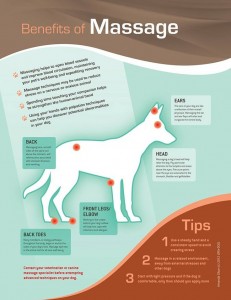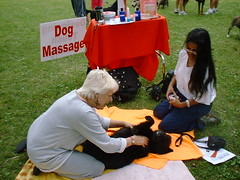 Most people enjoy a nice, long relaxing massage. Why wouldn’t pets like one too? It turns out that with the increase in the number of holistic veterinarians that massage and acupuncture have become big news in the canine world too.
Most people enjoy a nice, long relaxing massage. Why wouldn’t pets like one too? It turns out that with the increase in the number of holistic veterinarians that massage and acupuncture have become big news in the canine world too.
My dogs are either way too hyper and energized away from the house or, in Sara’s case, very wary of strangers, so finding a dog masseuse isn’t an option for me. Luckily, there are loads of resources out there for people such as myself to learn how to give your dog a relaxing massage.
Massaging your pets is extremely beneficial for both you and your pet! First, the contact between you and your pet increases the human-canine bond that you feel and releases endorphins in both of your blood streams. Even if Fido is the one being massaged, you’ll reap the benefit and feel calmer too.
Secondly, massage increases circulation, eases constipation, lowers blood pressure, relaxes stiff muscles, and regular massage can help you find anomalies (like lumps and bumps) on your pet before they become problematic. There are schools where you can go to learn specific canine massage techniques, such as Tellington Touch (TTouch massage), Acupressure, Healing Touch therapies or Reiki therapy. The purpose of this article is to instruct you on giving a basic, relaxing massage to your pet and is not intended to be used to diagnose or treat ailments without the aid of your veterinarian.
Here is my method to learn how to massage a dog, feel free to change it up as you see fit while you working with your dog, since every canine is an individual.
When I start a massage, I first wait until my dog is relaxed and/or sleeping in a comfortable area. Trying to massage a dog who wants to play fetch isn’t going to work out well. I find that Barret will find me and crawl into my lap when he is ready for a massage.
 I’ll approach slowly and quietly, but too stealthily… never startle a sleeping dog. That’s just asking for an unintended bite. I’ll sit cross legged with them in front of me and begin by making long, gentle strokes from their forehead to the end of their tail. I keep all my movements slow and relaxing.
I’ll approach slowly and quietly, but too stealthily… never startle a sleeping dog. That’s just asking for an unintended bite. I’ll sit cross legged with them in front of me and begin by making long, gentle strokes from their forehead to the end of their tail. I keep all my movements slow and relaxing.
After that, I use a massaging dog brush in the same way, to stimulate the hair follicles and blood circulation.
Next, I start making gentle circles with my finger tips and move up and down the spine, alternating between the left and right hand side. Then, I massage their faces, around the ears, gently sweeping my fingers around their eyes and chin for a few minutes. All the while, I’m cooing and telling them how good they are and how much I love them. I really find this helps you connect with your pet in a more meaningful manner. All of that was to just relax them even further and get them ready for their massage.
 Now we’re ready to begin the healing massage. I’ll run my hands up and down their body, all while feeling closely for areas of the body that are very tense (feel for hard knots in the muscles), areas that feel warmer than the rest of the body, or areas that twitch when they’re stroked. Those are all signs of tension, inflammation, or general discomfort in that area.
Now we’re ready to begin the healing massage. I’ll run my hands up and down their body, all while feeling closely for areas of the body that are very tense (feel for hard knots in the muscles), areas that feel warmer than the rest of the body, or areas that twitch when they’re stroked. Those are all signs of tension, inflammation, or general discomfort in that area.
I’ll use Sara as an example. Her lower back is usually very tight and knotted up. At this stage I will still be using slow, gentle circles on the skin, but I will increase the pressure and intensity so that I am now massaging muscle rather than just the skin. Barret, on the other hand, usually has heat surrounding where his leg used to be (He’s a tripawd now since he was diagnosed with cancer). This area, while healed, is still tender for him and I’ve learned he doesn’t like to be massaged there, so I focus on areas where he does enjoy a good massage, like right above his tail.
Be sure to take cues from your dog and to be very aware of their body language. If they really tense up or turn or sit up suddenly when you touch an area, it is particularly sensitive or they don’t like being touched there. Respect that, but also be sure to investigate the area for lumps, bumps or other abnormalities that you may want to have a vet check out for you.
Of course, if at any time they want to get up and leave, let them go. I don’t force a massage, but I’ve never found anyone all that willing to leave unless the doorbell rang or they saw a squirrel in the yard!
 That Pet Blog That Pet Place Pet Blog
That Pet Blog That Pet Place Pet Blog

I have a shiba inu/lab mix, and it never occured to me that dogs would like to be massaged, but it makes sense! It’s also a great idea to use that time to check for any lumps or bumps on your dog to be checked out by the vet. I am definitely going to try this!